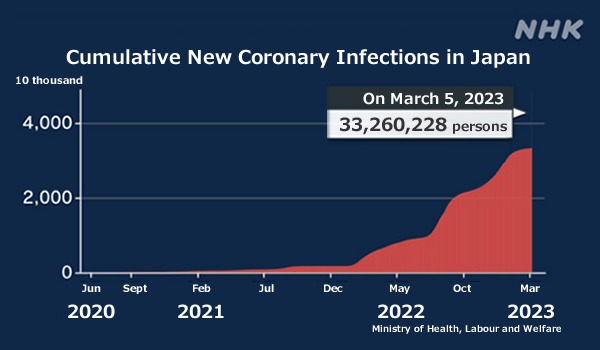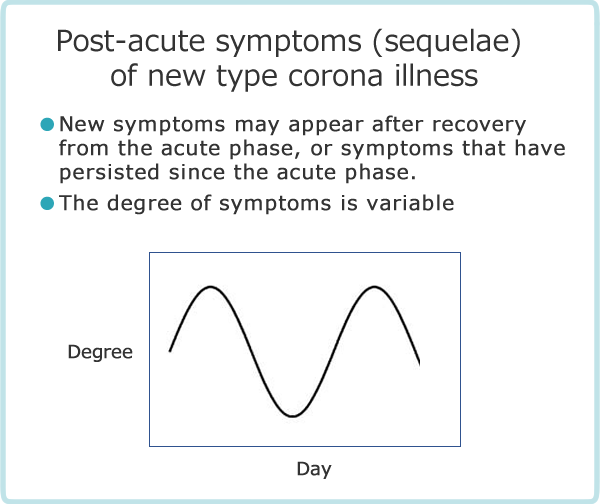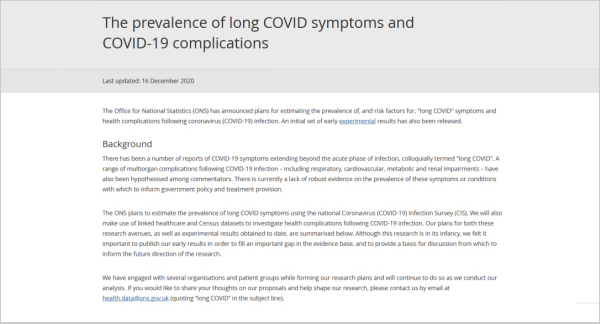Medical Treatment
Consultation for new corona-related sequelae
Introduction
We provide consultation (including issuance of medical certificates), diagnosis, and treatment of new corona sequelae and long-term adverse reactions (sequelae) to vaccines. New corona infection, which began in 2020, is a global problem and has a significant social impact on our country. Although it will be classified as a category 5 infectious disease, equivalent to influenza, on May 8, 2023, many issues remain to be solved, including the problem of the aftereffects of the new corona infection.
Figure 6-1 shows the cumulative total of new corona infections in Japan as of March 5, 2023, reaching 33.26 million cases.

From a cumulative total of 33.26 million infected people, assuming that 10% of them have sequelae (lasting more than three months),
the number of patients with sequelae is estimated to be 3,326,000. (NHK survey).
| Post-exposure symptoms (sequelae) of new coronavirus | After contracting a novel coronavirus |
| Despite no longer being contagious | |
| Persistence for at least 2 months | |
| No other apparent cause |
Table 6-1. WHO definition of sequelae of new coronavirus infection.
Table 6-1 shows the WHO definition of the sequelae of novel coronavirus. It is defined as symptoms that persist for more than two months after a new coronavirus illness without any other cause. Most people recover with a mild illness, but some may have these persistent symptoms.

Symptoms include those that persist from the acute phase of the new coronas and those that newly appear after recovery from the acute phase, as shown in Table 6-2. In addition, the severity of symptoms often shows daily fluctuations.
| Fatigue and feebleness | Memory impairment | Palpitations |
| Joint pain | Concentration problems | Diarrhea |
| Muscle pain | Insomnia | Abdominal pain |
| Cough and phlegm | Headache | Sleep disturbance |
| Shortness of breath | Depression | Muscle weakness |
| Chest pain | Taste disorder | |
| Hair loss | Olfactory disorder |
Table 6-3. Typical symptoms of novel coronavirus sequelae
From COVID-19 Guideline for the Medical Treatment of New Coronavirus Infections (2023)
Table 6-3 shows typical symptoms of post-neoplastic coronary sequelae. It shows a wide variety of systemic symptoms. Among these, fatigue/feebleness, arthralgia, and myalgia are the most typical. Fatigue/feebleness are the most common symptoms, and in severe cases, it is not uncommon for patients to miss long periods of time from work or school. Headache is also a common complaint. In some cases, common headache medications are ineffective. Shortness of breath is another common symptom, as coronas damage the lungs. Some young people may be so short of breath that they cannot climb stairs, or even walk a full circle around the house. Pulmonary function tests may show abnormalities.
Since the outbreak of the new coronary infection in 2020, there has been an increase in the number of consultations for people with the sequelae of the new coronary disease. Related sequelae include general fatigue like chronic fatigue syndrome, stiff shoulders, slight fever, taste disorder, olfactory disorder, depressive symptoms, and cognitive impairment such as forgetfulness and poor thinking (brain fog: symptoms of poor thinking, poor concentration, poor memory, and a foggy feeling in the head). A wide variety of symptoms such as ophthalmoplegia (double vision), severe dizziness, postherpetic neuralgia, cough, throat discomfort, nasal discharge, recurrent vomiting, joint pain throughout the body, arm pain and numbness, palpitations, myocardial infarction, pericarditis and myocarditis, acute nephritis and renal failure, and more.
These patients are treated with new meridian therapy and Chinese herbal medicine, and their progress is good. Myocardial infarction, pericarditis, and acute nephritis were referred to specialists for treatment.
Frequency of new corona sequelae
What then is the frequency of new-type corona sequelae?
Figure 6-2 shows a paper on new-type corona sequelae published by the UK Office for National Statistics. It reports that 10% of people infected with new coronas develop coronary sequelae lasting more than 12 weeks (The prevalence of long COVIDS). (If we apply this to the total number of people infected in Japan, it is possible that nearly 3 million people are suffering from sequelae.

We are currently treating patients with herpes zoster and postherpetic neuralgia as a new corona-related sequelae. It also provides advice on medical certificates for absence from work and sickness benefits. Please call first for a consultation.